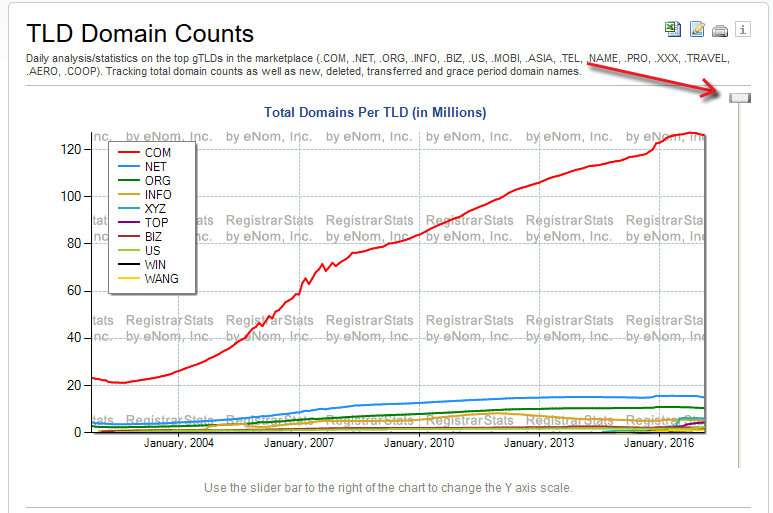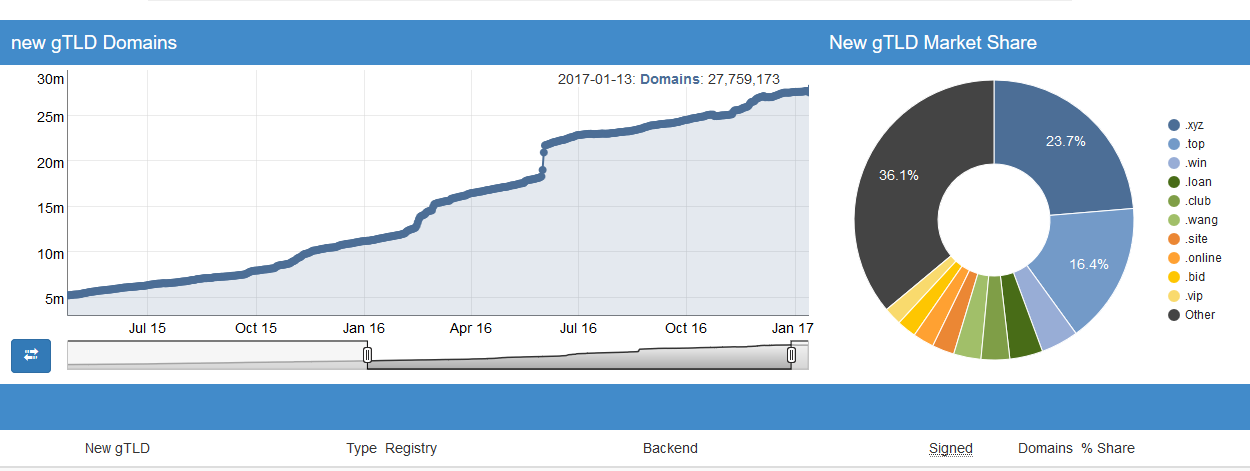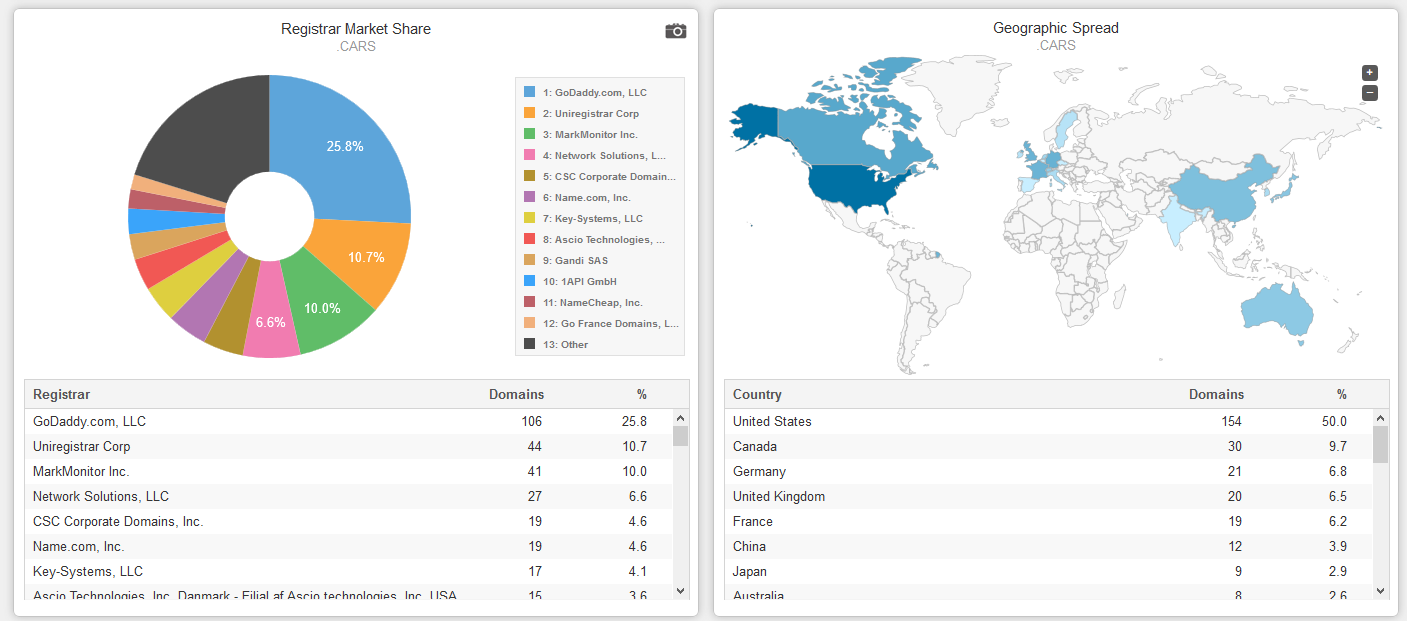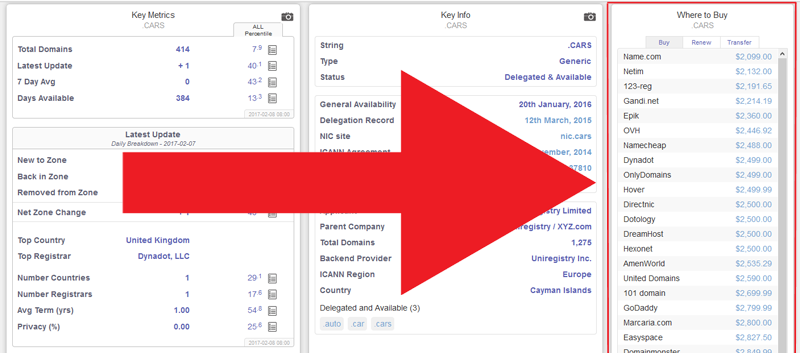NEW YORK, NY – As should be no surprise, new gTLD growth and usage is on the rise exponentially. There are several tools available for measuring gTLD growth and market share which are ‘fairly accurate’ as they use the DNS Zone File system which maps domain names and IP addresses. One such tool which I originally thought was new is ntldstats.com, although the owner Stefan Meinecke was interviewed back in 2014 by TheDomains.com – so it is far from new.
Another interesting tool I discovered online is https://namestat.org. This one has also been around since 2014 and also happens to have been highlighted by TheDomains.com as well. Seems Michael Berkens has had the scoop on both of these interesting tools before most likely even knew about them. This tool also offers insights and data for measuring gTLD growth and market share.
In addition to general market share and growth, namestat.org also offers a unique feature which is very helpful in measuring where to get the best price on particular domain extensions by listing the sales price of each registrar group; Awesome!
Over towards the right you will notice each registrar which offers the domain for sale is listed with its retail price. Yes, that is the current price of the initial registration and renewal fee of the .cars domain.
RegistrarStats.com offers a editable graph for TLD Domain Counts with daily analysis and statistics on the top gTLDs in the marketplace (.COM, .NET, .ORG, .INFO, .BIZ, .US, .MOBI, .ASIA, .TEL, .NAME, .PRO, .XXX, .TRAVEL, .AERO, .COOP). Tracking total domain counts as well as new, deleted, transferred and grace period domain names.

If these two tools do not keeping you digging through all of this valuable information for the next hour or so, the following other resources are also available for your gTLD data gathering delight:
- Generic Top-Level Domains Delegated Strings (ICANN)
- New Pending gTLD Applications w/ Linked Status (ICANN)
- Overall New gTLD Current Statistics (Updated monthly)
- Internet Statistics for New TLDs (DomainTools.com)
- gTLD Marketplace Health Index (PDF) June 2016 (ICANN)

About The Author: John Colascione is Chief Executive Officer of Internet Marketing Services Inc. He specializes in Website Monetization, is a Google AdWords Certified Professional, authored a ‘how to’ book called ”Mastering Your Website‘, and is a key player in several Internet related businesses through his search engine strategy brand Searchen Networks®

 *** Here Is A List Of Some Of The Best Domain Name Resources Available ***
*** Here Is A List Of Some Of The Best Domain Name Resources Available ***


In the first graph you cut off the February stats that show the number of new gTLDs has peaked and, with the impending Chinese drops, is in terminal decline.
Most of the this “growth” is false John… just look at samples of the domains that are deleting from the larger new registries, and you will see endless streams of 40 character gibberish that look like in mass a computer program picked them out to pad perceptions of size for value association. This is the problem with 1000 cowboy extensions and the ability to set pricing and subsidize privately to create false illusion. Spend some time calling real company owners and you will discover a 99% non-recognition rate for new GTLDS. The domaining industry has been pounding artificial purchases on these names for two years now, and targeting domainers almost exclusively who are after their pot of gold. Even when every ad agency in America comes together and signs letters stating dozens of reasons they will never be accepted, key figures in this arena still try and work their magic. Which is supported by industry pundits writing letters like the above with what appears to be a clear agenda to support it. Truth over fiction educates and evolves, while misleading stats, wrong sales reporting, and the rest of it causes the worst of the new GTLD bunch to continue with business as usual instead of advancing their advertising and market penetration capabilities. Your are just helping to feed the secular sharks.
Very nice article, John, showing some of the best resources for looking at TLD registration patterns.
1 criticism, though, about the opening sentence: “[N]ew gTLD growth and usage is on the rise exponentially.”
Even if the nTLDs are growing, there’s a very precise meaning to the concept of exponential growth – specifically, a population whose rate of growth is proportional to its size. Unless the curve fits the equation e^(rt), then growth isn’t exponential. In fact, the graph doesn’t show exponential growth. That’s not a failure of the nTLD program; there’s no reason to expect that particular kind of growth, actually. We ought to be careful about using the phrase, since it doesn’t fit what we’d expect nor what we observe.
This may seem really pedantic of me – pointing this out. The only reason I’m rattling on about it is that I’d like to be able to discuss the nTLD growth rate in articles later on. And I’d need to rely on readers having a precise idea of what’s meant by “exponential growth” and “exponential decay”. If such phrases are overused, then it becomes harder for me to communicate about the nTLD program.
Thank you Joseph. As F Carson had pointed out before you, there is a lot of misconception out there on gTLDs. It is funny, one thing I have noticed is that when I write an article that appears positive for gTLDS, I think a lot of people assume I am for them, spreading positive news about them. When I write something negative about gTLDS, I think many people just assume I am negative on them over all.
The reality of it is, I am actually pretty neutral on the entire gTLD issue. I have a bunch of them myself, but I’m trying to not bank on them. I’m just in the game with them, because you have to be in to win it. So I have picked up some here and there and am even running sites on some of them.
These tools above are great to measure and read into gTLD data, but I did not factor in any fraud or deceptive tactics, such as what F Carson brought up on bogus registrations. He is probably right – its probably happening left and right, but it is very unfortunate that it is happening, so again, I did not take fraud or deception into consideration when showing the graphs and tools.
It seems growth and use it up, because in the last year, there is so many more extensions then there were in the past. This doesn’t necessarily mean that brands are opting to redirect their .coms to their new gtlds, because they’re not doing that all. But I believe registration itself of gTLDs is in fact up.